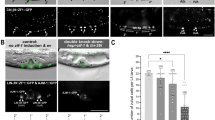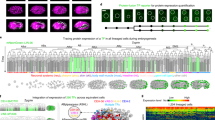Abstract
The nematode Caenorhabditis elegans offers a powerful model system to study cell division control during animal development. Progress from the one-cell zygote to adult stage follows a nearly invariant pattern of divisions. This, combined with a transparent body and efficient genetics, allows for sensitive identification and quantitative analysis of cell-cycle mutants. Nearly all G1 control genes identified in C. elegans have mammalian homologs. Examples include a D-type cyclin and CDK4/6-related kinase, a member of the retinoblastoma protein family and CDK inhibitors of the Cip/Kip family. Genetic studies have placed the currently known G1 regulators into pathways similar to those in mammals. Together, this validates the use of C. elegans in identifying additional regulators of cell-cycle entry and exit. For instance, we recently found that the CDC-14 phosphatase promotes maintenance of the quiescent state. Here, we describe cell-cycle control as an integral part of C. elegans development, summarize current knowledge of G1 control genes in the worm, compare the results with those obtained in other species, and discuss the possible implications of cell-cycle studies in C. elegans for higher organisms, including humans.
This is a preview of subscription content, access via your institution
Access options
Subscribe to this journal
Receive 50 print issues and online access
$259.00 per year
only $5.18 per issue
Buy this article
- Purchase on Springer Link
- Instant access to full article PDF
Prices may be subject to local taxes which are calculated during checkout



Similar content being viewed by others
References
Berthet C, Aleem E, Coppola V, Tessarollo L and Kaldis P . (2003). Curr. Biol., 13, 1775–1785.
Boxem M, Srinivasan DG and van den Heuvel S . (1999). Development, 126, 2227–2239.
Boxem M and van den Heuvel S . (2001). Development, 128, 4349–4359.
Boxem M and van den Heuvel S . (2002). Curr. Biol., 12, 906–911.
Brenner S . (1974). Genetics, 77, 71–94.
Brodigan TM, Liu J, Park M, Kipreos ET and Krause M . (2003). Dev. Biol., 254, 102–115.
Ceol CJ and Horvitz HR . (2001). Mol. Cell, 7, 461–473.
Ceol CJ and Horvitz HR . (2004). Dev. Cell, 6, 563–576.
Datar SA, Jacobs HW, de la Cruz AF, Lehner CF and Edgar BA . (2000). EMBO J., 19, 4543–4554.
Derry WB, Putzke AP and Rothman JH . (2001). Science, 294, 591–595.
Edgar LG and McGhee JD . (1988). Cell, 53, 589–599.
Fay DS and Han M . (2000). Development, 127, 4049–4060.
Fay DS, Keenan S and Han M . (2002). Genes Dev., 16, 503–517.
Feng H, Zhong W, Punkosdy G, Gu S, Zhou L, Seabolt EK and Kipreos ET . (1999). Nat. Cell Biol., 1, 486–492.
Ferguson EL and Horvitz HR . (1989). Genetics, 123, 109–121.
Fire A, Xu S, Montgomery MK, Kostas SA, Driver SE and Mello CC . (1998). Nature, 391, 806–811.
Fukuyama M, Gendreau SB, Derry WB and Rothman JH . (2003). Dev. Biol., 260, 273–286.
Geng Y, Yu Q, Sicinska E, Das M, Schneider JE, Bhattacharya S, Rideout WM, Bronson RT, Gardner H and Sicinski P . (2003). Cell, 114, 431–443.
Gruneberg U, Glotzer M, Gartner A and Nigg EA . (2002). J. Cell Biol., 158, 901–914.
Hedgecock EM and White JG . (1985). Dev. Biol., 107, 128–133.
Hong Y, Roy R and Ambros V . (1998). Development, 125, 3585–3597.
Horvitz HR and Sulston JE . (1980). Genetics, 96, 435–454.
Kamath RS and Ahringer J . (2003). Methods (Duluth), 30, 313–321.
Kemphues KJ and Strome S . (1997). C. elegans II. Riddle DL, Blumenthal T, Meyer BJ and Priess JR (eds). Cold Spring Harbor Laboratory Press: New York, pp. 335–359.
Kimura KD, Tissenbaum HA, Liu Y and Ruvkun G . (1997). Science, 277, 942–946.
Kipreos ET, Gohel SP and Hedgecock EM . (2000). Development, 127, 5071–5082.
Kipreos ET, Lander LE, Wing JP, He WW and Hedgecock EM . (1996). Cell, 85, 829–839.
Kostic I, Li S and Roy R . (2003). Dev. Biol., 263, 242–252.
Kozar K, Ciemerych MA, Rebel VI, Shigematsu H, Zagozdzon A, Sicinska E, Geng Y, Yu Q, Bhattacharya S, Bronson RT, Akashi K and Sicinski P . (2004). Cell, 118, 477–491.
LaBaer J, Garrett MD, Stevenson LF, Slingerland JM, Sandhu C, Chou HS, Fattaey A and Harlow E . (1997). Genes Dev., 11, 847–862.
Lambie EJ . (2002). BioEssays, 24, 38–53.
Lee RC, Feinbaum RL and Ambros V . (1993). Cell, 75, 843–854.
Lu X and Horvitz HR . (1998). Cell, 95, 981–991.
Malumbres M, Sotillo R, Santamaria D, Galan J, Cerezo A, Ortega S, Dubus P and Barbacid M . (2004). Cell, 118, 493–504.
Mendenhall MD . (1993). Science, 259, 216–219.
Meyer CA, Jacobs HW, Datar SA, Du W, Edgar BA and Lehner CF . (2000). EMBO J., 19, 4533–4542.
Meyer CA, Jacobs HW and Lehner CF . (2002). Curr. Biol., 12, 661–666.
Mishima M, Pavicic V, Gruneberg U, Nigg EA and Glotzer M . (2004). Nature, 430, 908–913.
Ortega S, Prieto I, Odajima J, Martin A, Dubus P, Sotillo R, Barbero JL, Malumbres M and Barbacid M . (2003). Nat. Genet., 35, 25–31.
Park M and Krause MW . (1999). Development, 126, 4849–4860.
Riddle DL and Albert PS . (1997). C. elegans II. Riddle DL, Blumenthal T, Meyer BJ and Priess JR (eds). Cold Spring Harbor Laboratory Press: New York, pp. 739–768.
Rual JF, Ceron J, Koreth J, Hao T, Nicot AS, Hirozane-Kishikawa T, Vandenhaute J, Orkin SH, Hill DE, van den Heuvel S and Vidal M . (2004). Genome Res., 14, 2162–2168.
Saito RM, Perrault A, Peach B, Satterlee JS and van den Heuvel S . (2004). Nat. Cell Biol., 6, 693–695.
Schedl T . (1997). C. elegans II. Riddle DL, Blumenthal T, Meyer BJ and Priess JR (eds). Cold Spring Harbor Laboratory Press: New York, pp. 241–269.
Schumacher B, Hofmann K, Boulton S and Gartner A . (2001). Curr. Biol., 11, 1722–1727.
Schwob E, Bohm T, Mendenhall MD and Nasmyth K . (1994). Cell, 79, 233–244.
Seydoux G, Savage C and Greenwald I . (1993). Dev. Biol., 157, 423–436.
Sherr CJ and Roberts JM . (1999). Genes Dev., 13, 1501–1512.
Shou W, Seol JH, Shevchenko A, Baskerville C, Moazed D, Chen ZW, Jang J, Charbonneau H and Deshaies RJ . (1999). Cell, 97, 233–244.
Solari F and Ahringer J . (2000). Curr. Biol., 10, 223–226.
Sulston JE and Horvitz HR . (1977). Dev. Biol., 56, 110–156.
Sulston JE and Horvitz HR . (1981). Dev. Biol., 82, 41–55.
Sulston JE, Schierenberg E, White JG and Thomson JN . (1983). Dev. Biol., 100, 64–119.
Visintin R, Craig K, Hwang ES, Prinz S, Tyers M and Amon A . (1998). Mol. Cell, 2, 709–718.
Visintin R, Hwang ES and Amon A . (1999). Nature, 398, 818–823.
Acknowledgements
We thank our many colleagues and collaborators for generously sharing reagents and ideas, and apologize to those whose valuable work could not be cited owing to space constraints. We thank Mike Boxem, John S. Satterlee and Inge The for their suggestions and critical review of the manuscript. This work was funded by grants from the Claudia Adams Barr Program (to JK) and the National Institutes of Health (to SvdH).
Author information
Authors and Affiliations
Corresponding author
Rights and permissions
About this article
Cite this article
Koreth, J., van den Heuvel, S. Cell-cycle control in Caenorhabditis elegans: how the worm moves from G1 to S. Oncogene 24, 2756–2764 (2005). https://doi.org/10.1038/sj.onc.1208607
Published:
Issue Date:
DOI: https://doi.org/10.1038/sj.onc.1208607
Keywords
This article is cited by
-
Boolean genetic network model for the control of C. elegans early embryonic cell cycles
BioMedical Engineering OnLine (2013)
-
The ancient function of RB-E2F Pathway: insights from its evolutionary history
Biology Direct (2010)
-
Spindle assembly checkpoint genes reveal distinct as well as overlapping expression that implicates MDF-2/Mad2 in postembryonic seam cell proliferation in Caenorhabditis elegans
BMC Cell Biology (2010)
-
Conserved functions of the pRB and E2F families
Nature Reviews Molecular Cell Biology (2008)
-
Cyclin E–Cdk2 temporally regulates centrosome assembly and establishment of polarity in Caenorhabditis elegans embryos
Nature Cell Biology (2006)



